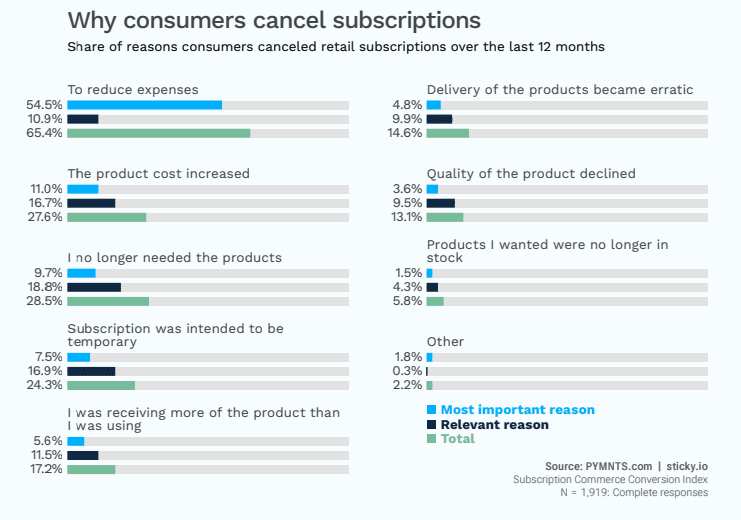Is inflation causing a “great unsubscribe,” or is it more a case of consumers becoming increasingly selective about their retail subscriptions? The truth is likely somewhere in between.
Tracking shifts in the sector over time, the Subscription Commerce Conversion Index, a PYMNTS and sticky.io collaboration, found that by March, an estimated 46 million consumers had canceled or paused their retail subscriptions in the prior year.
It’s an earthshaking number considering the retail subscriptions alone were generating roughly $15 billion per month for subscription brands through last year.
Inflation is playing a part, as would be expected, with the Subscription Commerce Conversion Index noting that “the share of nonsubscribers citing cost as the most important reason why they did not enroll with a retail subscription service skyrocketed from 2% in October 2021 to 22% in March 2022, and this reason became the most frequently cited main hindrance to subscription enrollment.”
Advertisement: Scroll to Continue
That edition of the study found total monthly expenditure on subscriptions down by 46% in March versus six months before.
In a subsequent interview, sticky.io President and CEO Brian Bogosian told PYMNTS’ Karen Webster: “There’s a lot of things you get digital subscriptions for, but this change in the economy is forcing people to say, ‘I’d better take a look at my bank statement and see what I am being debited for every month’ and be a more cost conscious of saving $15 here, $25 there, because it all adds up.”
Read more: Inflation Forces Change or Churn Dilemma for Subscription Companies
 Subscription Sluggishness Sets In
Subscription Sluggishness Sets In
Among existing subscribers, talk is more around “subscription fatigue” — consumers having amassed an assortment of subscriptions during the pandemic and now tiring of these experiences or finding them no longer relevant as the pandemic slowly fades.
Major retailers — particularly in the apparel sector — all wanted in on the pandemic subscription boom, CNBC reported Friday (Aug. 12).
“Now, some analysts and investors are questioning the appeal of these types of businesses and their ability to hold onto customers, who often sign up during a big life change but eventually lose interest,” the report stated.
CNBC focused on the issues of subscription brands in the apparel sector, notably Stitch Fix.
“In the company’s most recent quarter ended April 30, Stitch Fix said it lost 200,000 active clients, bringing its total count to 3.9 million,” the report stated. “Its net loss ballooned to $78 million, from a loss of $18.8 million a year ago. The company announced it was laying off 15% of its salaried workers, or about 330 people.”
By no means a standout in the subscription shakeup, issues at Stitch Fix reflect the wider trend of consumers receiving boxes of stuff that they’re barely using at this point — there’s only so many bottles of hot sauce one can consumer each month — as well as shifts in fashion trends from pandemic athleisure wear to more stylish fashions for a reopening world.
More subscription brands are addressing fatigue with deeper personalization of boxes, as well as features like subscription pause to stem the loss. It’s important that brands move quickly on this front.
As the Subscription Commerce Index stated, “29% of retail subscribers feel decreased loyalty to their current subscription services due to increasing costs, irregular deliveries and a lack of product availability, and subscribers may cancel or pause their subscriptions if the balance between cost and value tips unfavorably.”
See also: With an Eye on Loyalty, Subscription Models Get a Post-COVID Refresh

